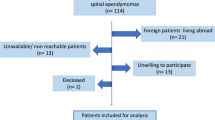Abstract
Ependymoma is a rare central nervous system tumor of adults. Reports of patient symptoms, interference patterns and costs encountered by patients and families are limited. Adult ependymoma patients completed the online Ependymoma Outcomes Questionnaire II. The survey assesses disease and functional status as well as socio-economic factors. Descriptive statistics were used to report disease characteristics as well as economic and social impact. Independent samples t test was used to test if differences exist between high- and low-income groups in terms of symptom severity. Correlations were calculated between symptoms and cost estimates. 86 international patients participated (male = 50 %). The economic analysis focused on 78 respondents from the US. 48 % were employed and 55 % earned ≥$60,000. Tumors were located in the brain (44 %), spine (44 %) or both (12 %). Spine patients compared to brain patients reported significantly worse pain (4.4 versus 2.2, p < .003), numbness (5.3 versus 2.2, p < .001), fatigue (5.1 versus 3.6, p < .03), changes in bowel patterns (3.8 versus 1.4, p < .003) and weakness (4.2 versus 2.1, p < .006). Brain patients compared with spine patients had increased lack of appetite (.4 versus 2, p < .014). Patients with lower income (≤$59,999) had more problems concentrating (p < .024) and worse cognitive module severity scores (p < .024). Estimated average monthly out-of-pocket spending was $168 for medical co-pays and $59 for prescription medication. Patients with ependymoma are highly affected by their symptoms. Spinal patients report higher severity of symptoms. Patients in the lower income group report significantly higher severity of cognitive symptoms independent of disease site.
Similar content being viewed by others
References
Ostrom QT, Gittleman H, Farah P, Ondracek A, Chen Y, Wolinsky Y, Stroup NE, Kruchko C, Barnholtz-Sloan JS (2013) CBTRUS statistical report: primary brain and central nervous system tumors diagnosed in the United States in 2006–2010. Neuro-oncol 15(Suppl 2):ii1–ii56. doi:10.1093/neuonc/not151
Louis DNOH, Wiestler OD, Cavenee WK (2007) Classification of tumours of the nervous system. IARC Press, Lyon
Donahue B, Steinfeld A (1998) Intracranial ependymoma in the adult patient: successful treatment with surgery and radiotherapy. J Neuro-oncol 37:131–133
Lee SH, Chung CK, Kim CH, Yoon SH, Hyun SJ, Kim KJ, Kim ES, Eoh W, Kim HJ (2013) Long-term outcomes of surgical resection with or without adjuvant radiation therapy for treatment of spinal ependymoma: a retrospective multicenter study by the Korea Spinal Oncology Research Group. Neuro-oncol 15:921–929
Morris K, Lye RH (1988) Ependymoma of the fourth ventricle: an unusual presentation. Br J Neurosurg 2:513–516
Reni M, Brandes AA (2002) Current management and prognostic factors for adult ependymoma. Exp Rev Anticancer Ther 2:537–545
Shaw EG, Evans RG, Scheithauer BW, Ilstrup DM, Earle JD (1987) Postoperative radiotherapy of intracranial ependymoma in pediatric and adult patients. Int J Radiat Oncol Biol Phys 13:1457–1462
Armstrong TS, Vera-Bolanos E, Gilbert MR (2011) Clinical course of adult patients with ependymoma: results of the Adult Ependymoma Outcomes Project. Cancer 117:5133–5141
Kucia EJ, Bambakidis NC, Chang SW, Spetzler RF (2011) Surgical technique and outcomes in the treatment of spinal cord ependymomas, part 1: intramedullary ependymomas. Neurosurg 68:57–63; discussion 63
Jayadevappa R, Schwartz JS, Chhatre S, Gallo JJ, Wein AJ, Malkowicz SB (2010) The burden of out-of-pocket and indirect costs of prostate cancer. Prostate 70:1255–1264
Kumthekar P, Stell BV, Jacobs D, Helenowski IB, Rademaker AW, Grimm S, Bennett CL, Raizer JJ (2014) Financial burden experienced by patients undergoing treatment for Malignant Gliomas. Neuro-Oncol Pract (in press)
Armstrong TS, Mendoza T, Gning I, Coco C, Cohen MZ, Eriksen L, Hsu MA, Gilbert MR, Cleeland C (2006) Validation of the M.D. Anderson symptom inventory brain tumor module (MDASI-BT). J Neuro-oncol 80:27–35
Armstrong TS, Gning I, Mendoza TR, Vera-Bolanos E, Gilbert MR, Rhines LD, Weinberg JS, Sanchez-Williams G, Levin V, Burton AW, Cleeland C (2010) Reliability and validity of the M. D. Anderson symptom inventory-spine tumor module. J Neurosurg 12:421–430
Serlin RC, Mendoza TR, Nakamura Y, Edwards KR, Cleeland CS (1995) When is cancer pain mild, moderate or severe? Grading pain severity by its interference with function. Pain 61:277–284
Mendoza TR, Wang XS, Cleeland CS, Morrissey M, Johnson BA, Wendt JK, Huber SL (1999) The rapid assessment of fatigue severity in cancer patients: use of the Brief Fatigue Inventory. Cancer 85:1186–1196
DeNavas-Walt C, Proctor BD (2014) Current population reports, P60-249. In: U.S. Department of Commerce USCB (ed) Income and poverty in the United States: 2013. U.S. Government Printing Office, Washington
Heese O, Schmidt M, Nickel S, Berger H, Goldbrunner R, Tonn JC, Bahr O, Steinbach JP, Simon M, Schramm J, Krex D, Schackert G, Reithmeier T, Nikkhah G, Loffler M, Weller M, Westphal M (2010) Complementary therapy use in patients with glioma: an observational study. Neurology 75:2229–2235
Funding
The work was supported by the Collaborative Ependymoma Research Network (CERN Foundation).
Conflict of interest
The authors make no disclosures.
Author information
Authors and Affiliations
Corresponding author
Additional information
On behalf of the CERN Foundation.
Rights and permissions
About this article
Cite this article
Walbert, T., Mendoza, T.R., Vera-Bolaños, E. et al. Symptoms and socio-economic impact of ependymoma on adult patients: results of the Adult Ependymoma Outcomes Project 2. J Neurooncol 121, 341–348 (2015). https://doi.org/10.1007/s11060-014-1638-4
Received:
Accepted:
Published:
Issue Date:
DOI: https://doi.org/10.1007/s11060-014-1638-4




